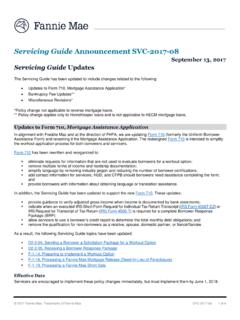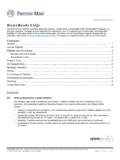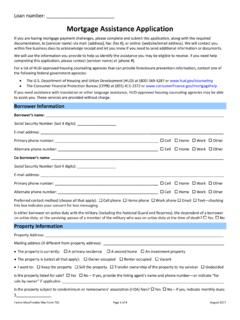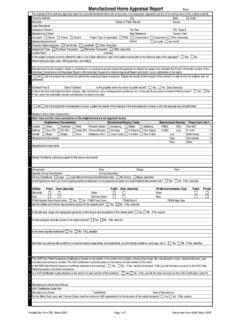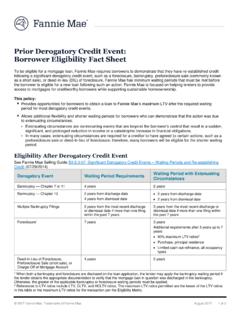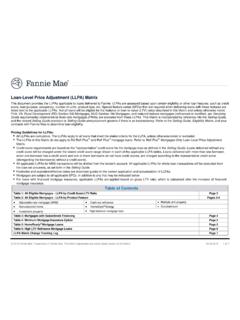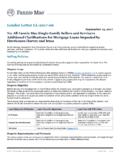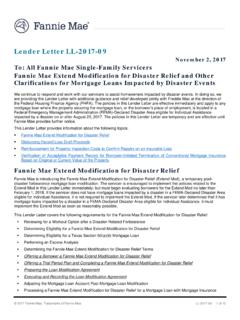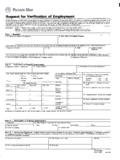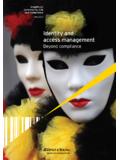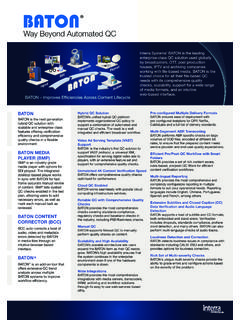Transcription of Beyond the Guide - Fannie Mae
1 Beyond the GuideHow to get the most from your quality control programDecember 2016iBeyond the GuideWelcome to Fannie Mae s significantly revised edition of Beyond the Guide , providing tips to help you get the most return on your quality control investment. When it was first published in 2010, Beyond the Guide was a ground-breaking statement of our commitment to building a lasting culture and framework for ensuring that loan quality was a permanent part of the industry s risk management principles. We provided insight into every area of mortgage loan manufacturing that could assist lenders in building their own capability for ensuring quality, and hence certainty around their reps and warrants. Our joint efforts have paid off. In late 2016, loan quality is at all-time highs, and repurchases are at all-time lows. Fannie Mae is committed to an ongoing partnership with our lenders to ensure your investment in loan quality contributes to your bottom line.
2 With our new Rep and Warrant framework, and as we learn and innovate with the industry, we found new challenges and many additional insights that we wanted to share toward our objective of continuously improving loan quality. This edition of Beyond the Guide reflects those fresh perspectives in areas like quality standards, action planning, and anti-fraud discipline. Just as important, this edition brings awareness to the impact of our unique technology advancements such as Collateral Underwriter and the DU validation service that enable both greater precision and efficiency in loan quality management. We outline how these new technologies are changing the responsibilities and focus of our joint quality control hope you find this latest edition of Beyond the Guide as valuable as the first one. It is written to be meaningful to every individual in your organization and we encourage you to share it that way. As always, we seek your feedback on this industry resource to improve its usefulness to Spies Vice President Loan Be sure to check out the many resources we provide on the Loan Quality web the GuideTable of Contents1 Beyond the GuideKeys to effective quality controlThe mortgage industry has undergone significant transformation over the past several years.
3 One area that has gained greater attention is the manufacturing quality of mortgages that are being originated. Fannie Mae has dedicated significant resources to help the industry re-establish the importance of loan quality as a key underpinning of the foundation that is needed to successfully manage this business. Loan quality is generally defined as mortgage loan files that contain accurate and sufficient documentation supporting a borrower s ability and willingness to repay. Acceptable and adequate collateral is also a key element of a quality loan. In addition, a quality loan meets internal corporate requirements, investor guidelines, and general eligibility standards as well as applicable federal, state, and local laws and regulations. The second edition of Beyond the Guide was developed to help lender organizations of all sizes implement a strong quality management process that is flexible to your firm s needs and helps increase your level of certainty about your current originations.
4 An effective, fully integrated quality control program can provide your business great value in these ways: Predictable Output Regardless of the path a lender takes to sell a loan into the secondary market or place into its own portfolio, having a loan that meets investor expectations or the lender s own requirements is a key tenet of risk management. It improves (or deters, if lacking) a lender s ability to make key, confident market decisions that ultimately impact the bottom line. Reliable Data Data accuracy is a constant pursuit in today s digital world and critical to a lender s operation. Many lenders spend time analyzing segments of the business that they are willing to lend in, but that analysis is all predicated on the final product or loan being what the lender expected. For example, does this loan really have a 75 percent loan-to-value ratio, a 23 percent debt-to-income ratio, and a 720 borrower credit score? Ensuring that loans are manufactured with a high degree of quality helps keep that data as reliable as possible.
5 Investor Confidence The entire industry makes risk decisions based on the accuracy of loan information and data. This is why Fannie Mae requires lenders to have effective quality control (QC) processes throughout their origination cycle. Our commitment to quality is demonstrated by Fannie Mae s long-term investment in systems, processes, and controls to help lenders originate quality loans that is, loans that meet investor and/or lender requirements. Reduced Cost To Produce Process efficiency is fundamental to achieving the lowest cost to produce a product. In today s highly competitive mortgage lending market, a lender s ability to produce investment-quality mortgages consistently, predictably, and efficiently can mean the difference between business success and failure. Properly implemented, a lender s QC process contributes to business profitability and long-term success. QC pays for the Guide expands on Fannie Mae s QC requirements described in Chapter D of the Fannie Mae Selling Guide .
6 The intent is to provide additional thoughts and insights to help lenders ensure that they have an effective quality management process. Nothing in this publication should be viewed as overriding or replacing Fannie Mae s lender QC requirements as described in the Selling Guide . In Beyond the Guide you will find ideas for meeting QC requirements effectively and enhancing your efforts Beyond the minimum Fannie Mae Selling Guide standards. These ideas include approaches that work for many of our lenders, do s and don ts that may prevent critical errors in the origination process, and other tips. Fannie Mae s Loan Quality page is another resource that provides tools, applications, and training to help your organization ensure its QC program is as comprehensive and effective as effective, fully integrated quality control program can provide your business great the GuideCulture: Creating a culture of quality management and board accountabilityWhy It MattersA lender s internal loan quality data should be viewed as a key performance indicator for the organization and should ensure that lenders are acting on the information generated from their respective pre- and post-funding quality reviews.
7 Too often, Fannie Mae engages with lenders and finds that the organization has a well-functioning QC team that provides timely and accurate information to leadership only for that information to not be acted upon. To be effective, QC must be a part of the company s culture and leveraged by senior management as a key measurement of operating efficiency and cost control. To be effective, QC must be a part of the company s culture and leveraged by senior management as a key measurement of operating efficiency and cost control. Fannie Mae Selling Guide RequirementsD1-1-01: Lender Quality Control Programs, Plans, and ProcessesThe Guide and Beyond the GuideLenders that embrace a successful quality culture employ similar tactics for implementing and driving quality in their organization. Fannie Mae conducts regular reviews of Fannie Mae Approved Sellers to evaluate compliance with our guidelines and assess the lender s operational risks. Reviews are conducted by the Mortgage Origination Risk Assessment (MORA) team, which operates independently of customer account relationship management in Fannie Mae s Single-Family Mortgage Business.
8 View an overview of the MORA the steps described below will help your organization create and live a quality culture that yields positive results for you and meets Fannie Mae s requirements. It is important that those who evaluate loan quality be independent of the production team. In addition, per Fannie Mae requirements (see D1-3-06), lenders must have an audit process in place and the results must be provided to management. If a lender outsources its QC file reviews, there should be rigorous, independent evaluation of the quality of the vendor s work (see D1-1-02) at least an annual review is highly recommended. A lender must sample 10% of the vendor s work monthly for possible missed/incorrect findings. Fannie Mae will evaluate the work of a QC vendor as rigorously as it evaluates the work of a lender. Outsourcing does not relieve the lender of responsibilities required by the Selling Guide . Fannie Mae s Selling Guide requires management accountability for loan quality.
9 When Fannie Mae conducts a MORA review, in addition to requiring that the lender provide their QC reports, we may ask for evidence of management control such as meeting minutes or company communications regarding loan quality. Fannie Mae will evaluate whether a lender that consistently exceeds its defect rate target and/or is ineffective in its QC poses additional risk to Fannie Mae and may require remedial a Target Defect RateA lender s senior management team and, if applicable, board of directors, should believe that loan quality is vital to a successful lending operation. The company should build into its risk culture a commitment to produce loans with file data that is accurate and complete to meet investor eligibility requirements, and to support a sound credit decision. This is achieved through metrics established by the board and with goal attainment tied to the lender s compensation the GuideAn effective way to establish loan quality targets is to model the financial exposure created at a certain defect level.
10 While attaining a zero defect rate over an extended period of time is mainly aspirational, your target defect rate should be set as reasonably low as possible and the organization should periodically reassess the target with the view of striving toward reducing defects over time. To the right is a simple illustration of how to determine a target defect the target is defined, the lender should build a culture of quality around its defect rate targets. Also, management and the board should review performance against the target at least quarterly and demand immediate action if defects exceed the target. The target should be evaluated at least annually, updating variables of performance, default, and capital needs. Fannie Mae s post-purchase QC reviews can provide guidance to help lenders assess the accuracy and effectiveness of their QC program. In a MORA review, Fannie Mae will assess how the lender s chosen defect rate affects our own risk exposure, and may provide input on the appropriateness of the targets.
